The direction of the magnetic force on a moving positively charged particle or a wire carrying current $i$ in a uniform magnetic field is determined by the right-hand rule, with different versions stated below.
Version 1 (right-hand rule): point the fingers of your right hand in the direction of $\vec v$ and curl them (through the smaller angle) toward $\vec B$. Your upright thumb shows the cross product $\vec v \times \vec B$ or the magnetic force $\vec F_B$. This force is perpendicular to the plane of $\vec v-\vec B$
Version 2 (right-hand rule): point your fingers in the direction of $\vec B$ so that the thumb points toward the velocity $\vec v$, your palm shows the direction of the magnetic force on a positive charge.
Note: the magnetic force on a negative charge is in the opposite direction to that given by the right-hand rule.
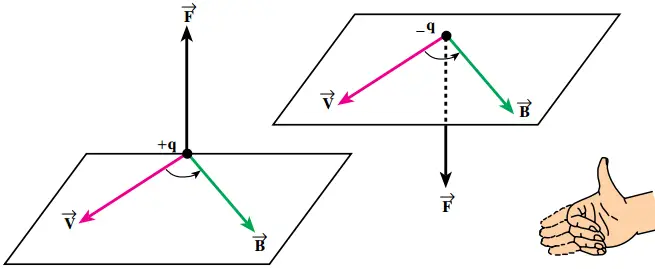
Right-Hand Rule: Example problems
Example (1): What is the direction of the magnetic field that produces the magnetic force on a positive charge in each of the figures below? (assuming $B$ is perpendicular to $v$).

Solution: right-hand rule states that, to determine the direction of the magnetic force on a positively charged particle, point the thumb of the right hand in the direction of $v$, the fingers in the direction of $B$, and your palm in the direction of the magnetic force $F$. Therefore, in the following figure, we have
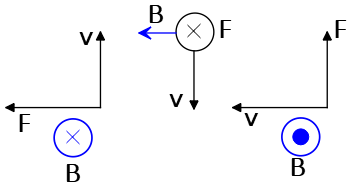
Where $\odot$ and $\otimes$ show the direction of the fields as outward and inward, respectively, perpendicular to the page.
Example (2): What is the direction of the magnetic force on a negative charge entering a uniform magnetic field B in the following figure?

Solution: put your right fingers along with the velocity such that your palm shows the direction of the magnetic field B. In this situation, your thumb, the direction of the magnetic force, goes into the page.
But note that this force is for a positive charge. For a negatively charged particle, simply reverse the above direction that is out of the page.
Example (3): Using the right-hand rule, find the direction of the magnetic force on the positively charged particle in the figure below.
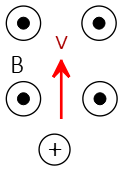
Solution: place your right hand on the plane, such that your fingers are directed along with the velocity V and the palm to the magnetic field. Your thumb shows the direction of the magnetic force on the positive charge. This is the right-hand rule.
In this problem, the thumb is toward the right.
Example (4): Repeat the problem above with a negative charge.
Solution: As a rule of thumb, to find the direction of the magnetic force on a negatively charged particle, first always suppose the charge is positive, find the force's direction on it, then reverse its direction to find the force's direction on the corresponding negative charge.
Hence, in this problem, the force is directed toward the left.
Example (5): Using the right-hand rule, find the direction of the velocity in the following figure.
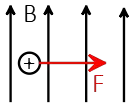
Solution: Recall that in the right-hand rule, each component of the right hand represents something.
The fingers indicate the direction of the particle's velocity
The thumb is for the direction of the magnetic force.
The palm shows the direction of the magnetic field.
Put your right hand on the page in the order described above. By doing this, your palm is facing up. Thus, the particle's velocity is out of the page.
Example (6): A steady current passes through the wires along with a long solenoid and produces a uniform magnetic field parallel to its axis. A positive charge moving along the axis of the solenoid enters into it. In what direction is the magnetic force applied to the charge?
Solution: Recall that the magnetic force on a charged particle is obtained by $F=q\vec{v}\times \vec{B}=qvB\sin \theta$ where $\theta$ is the angle between the particle's velocity and the magnetic field.
Here, this angle is zero because both the velocity and magnetic field are in the same direction.
Hence, no magnetic force is applied to the particle.
Example (7): a negatively charged particle, moving to the right along a horizontal plane, is entering into a region of uniform magnetic field directed into the page. In what direction is the magnetic force?
Solution: First, visualize what is being said in the following figure.
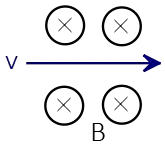
Now apply the right-hand rule: your right fingers along with the velocity so that the palm is in the direction of the magnetic field. The thumb, which indicates the force's direction, is upward.

 kinematic
kinematic
 Electrostatic
Electrostatic
 Magnetism
Magnetism